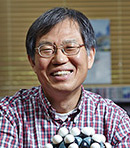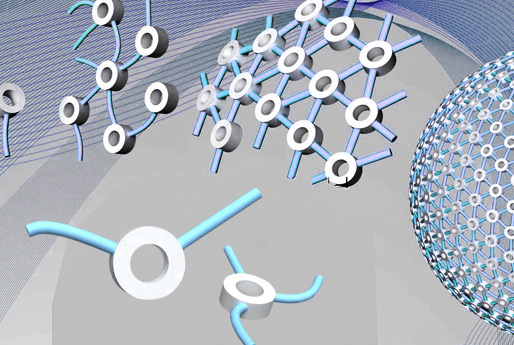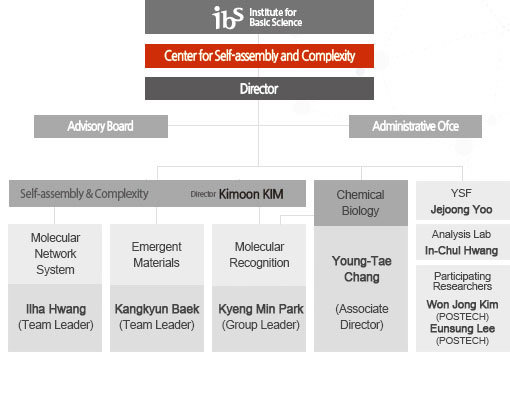주메뉴
- About IBS 연구원소개
-
Research Centers
연구단소개
- Research Outcomes
- Mathematics
- Physics
- Center for Underground Physics
- Center for Theoretical Physics of the Universe (Particle Theory and Cosmology Group)
- Center for Theoretical Physics of the Universe (Cosmology, Gravity and Astroparticle Physics Group)
- Dark Matter Axion Group
- Center for Artificial Low Dimensional Electronic Systems
- Center for Theoretical Physics of Complex Systems
- Center for Quantum Nanoscience
- Center for Exotic Nuclear Studies
- Center for Van der Waals Quantum Solids
- Center for Relativistic Laser Science
- Chemistry
- Life Sciences
- Earth Science
- Interdisciplinary
- Center for Neuroscience Imaging Research (Neuro Technology Group)
- Center for Neuroscience Imaging Research (Cognitive and Computational Neuroscience Group)
- Center for Algorithmic and Robotized Synthesis
- Center for Nanomedicine
- Center for Biomolecular and Cellular Structure
- Center for 2D Quantum Heterostructures
- Institutes
- Korea Virus Research Institute
- News Center 뉴스 센터
- Career 인재초빙
- Living in Korea IBS School-UST
- IBS School 윤리경영


주메뉴
- About IBS
-
Research Centers
- Research Outcomes
- Mathematics
- Physics
- Center for Underground Physics
- Center for Theoretical Physics of the Universe (Particle Theory and Cosmology Group)
- Center for Theoretical Physics of the Universe (Cosmology, Gravity and Astroparticle Physics Group)
- Dark Matter Axion Group
- Center for Artificial Low Dimensional Electronic Systems
- Center for Theoretical Physics of Complex Systems
- Center for Quantum Nanoscience
- Center for Exotic Nuclear Studies
- Center for Van der Waals Quantum Solids
- Center for Relativistic Laser Science
- Chemistry
- Life Sciences
- Earth Science
- Interdisciplinary
- Center for Neuroscience Imaging Research (Neuro Technology Group)
- Center for Neuroscience Imaging Research (Cognitive and Computational Neuroscience Group)
- Center for Algorithmic and Robotized Synthesis
- Center for Nanomedicine
- Center for Biomolecular and Cellular Structure
- Center for 2D Quantum Heterostructures
- Institutes
- Korea Virus Research Institute
- News Center
- Career
- Living in Korea
- IBS School
Research Centers
- Research Outcomes
- Mathematics
- Physics
- Center for Underground Physics
- Center for Theoretical Physics of the Universe (Particle Theory and Cosmology Group)
- Center for Theoretical Physics of the Universe (Cosmology, Gravity and Astroparticle Physics Group)
- Dark Matter Axion Group
- Center for Artificial Low Dimensional Electronic Systems
- Center for Theoretical Physics of Complex Systems
- Center for Quantum Nanoscience
- Center for Exotic Nuclear Studies
- Center for Van der Waals Quantum Solids
- Center for Relativistic Laser Science
- Chemistry
- Life Sciences
- Earth Science
- Interdisciplinary
- Center for Neuroscience Imaging Research (Neuro Technology Group)
- Center for Neuroscience Imaging Research (Cognitive and Computational Neuroscience Group)
- Center for Algorithmic and Robotized Synthesis
- Center for Nanomedicine
- Center for Biomolecular and Cellular Structure
- Center for 2D Quantum Heterostructures
- Institutes
- Korea Virus Research Institute
Pushing the limits of self-assembly
Tel. +82-54-279-9932
Fax +82-54-279-9939
IBS Center for Self-assembly and Complexity
Room 112-1, No.1 Laboratories Building, POSTECH,
77, Cheongam-ro, Nam-gu, Pohang, Gyeongsangbuk-do
Director

Director KIM Kimoon
Professor Kim is the director of the Center for Self-Assembly and Complexity, established in August 2012. Director Kim received his Ph.D. in 1986 from the University of Stanford, he had previously gained his M.S. from the Korea Advanced Institute of Science (KAIST). In 1997 he was announced as the Director of the Center for Smart Supramolecules (CSS) within Pohang University of Science and Technology (POSTECH).
He was promoted to a Fellow at POSTECH in 2009 previous to his directorship at IBS.
Introduction

Understanding the fundamental principles behind complexity and emergence in selfassembly
- - Studying self-assembly under non-equilibrium conditions and developing molecular network systems
- - Developing new types of materials such as emergent nanomaterials with fundamentally novel characteristics via self-assembly
Main research activities
Our research center studies self-assembly in complex environments and habitats where a number of elements are known to mix in the natural world. We also study well-refined, contained environments (the main area of research up to now) so that we can overcome existing limitations of research into self-assembly. One objective is to study the manifest specific properties of self-assembly by either controlling specific variables or by producing materials with such properties.
If our trials are successful, we should be able to develop previously undiscovered molecular aggregates and materials that have outstanding properties and functions. These valuable materials can be used for making tools that diagnose and treat cancers in the early stages. We can also use them for the development of technologies for producing or storing clean energy (e.g., solar power, hydrogen, etc.).
In addition, our studies on self-assembly in complex environments should elucidate some of nature's underlying puzzles. Questions on the chemical origins of life can be answered with a deeper understanding of self-assembly.
Organization

Main research results
- A NIR probe tracks and treats lung tumor initiating cells by targeting HMOX2
(Journal of the American Chemical Society, 2019) - Visualizing microglia with a fluorescence turn-on Ugt1a7c substrate
(Angew. Chem. Int. Ed., 2019) - Supramolecular latching system based on ultrastable synthetic binding pairs as versatile tools for protein imaging
(Nature Communications, 2018) - Smart SERS Hot Spots: Single Molecules Can Be Positioned in a Plasmonic Nanojunction Using Host–Guest Chemistry
(Journal of the American Chemical Society, 2018) - Enrichment of Specifically Labeled Proteins by an Immobilized Host Molecule
(Angew. Chem. Int. Ed., 2017) - Hollow Nanotubular Toroidal Polymer Microrings
(Nature Chemistry, 2014)
Personnel
| Total | 56 |
|---|---|
| Gender | 46(Male), 10(Female) |
| Korean/ International | 45(Korean), 11(International) |
Degree
Position
As of October. 2019












